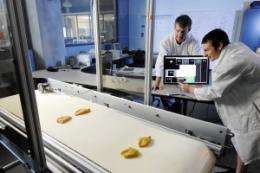Ready-to-Eat: Imaging System Monitors Oven Loading in Fully Cooked Meat Operations to Ensure Quality

(PhysOrg.com) -- Fully cooked, ready-to-eat products continue to increase in popularity among consumers because of their convenience. However, cooking these products requires careful control to ensure that the product is not overcooked or undercooked. While overcooking can cause quality deterioration, undercooking can create an unsafe product.
“Food safety is a critical issue, so producers often compensate for natural variability in the product and variability in the measurement process by overcooking products,” said Georgia Tech Research Institute (GTRI) senior research engineer John Stewart. “But overcooking wastes energy, degrades product quality, lowers the maximum throughput rate of the production line and decreases product yield.”
At typical production rates of 6,000 pounds per hour, the losses from overcooking can have a significant financial impact on producers. To minimize both undercooking and overcooking, Stewart and his colleagues at GTRI built a system that measures the three-dimensional shape and surface temperature of every piece of meat before it enters the oven.
Currently, after meat products travel through an oven for cooking, technicians randomly probe samples with thermocouple insertion probes to ensure that the product reached the minimum required cooking temperature.
“We’re focusing on analyzing the product before it goes into the oven because at that stage, there is still time to make changes in the cooking time or temperature to ensure that all pieces get cooked adequately,” explained Stewart. “Once the product comes out of the oven, it’s too late to correct any undercooking.”
The system consists of two commercially available cameras — a wide-area three-dimensional camera and an infrared camera — mounted above a 48-inch-wide processing conveyor belt. By measuring the three-dimensional profile of the meat, the screening system can identify individual products and detect arrangement issues such as overlapping product.
Locating individual pieces of meat on the conveyor belt can be challenging because producers often place products very close together to maximize throughput. In addition, thermal cameras sometimes view the product and conveyor belt temperatures as close to the same, which provides very little contrast.
“The height information offers much better contrast between pieces of meat, but sometimes further image processing is still required to determine the boundaries between individual products if they are only separated by a small gap or are touching,” added Stewart.
Once individual product shapes have been measured, they are compared with a library of previously recorded cooking results for meat products with a similar shape and a cook profile that matches the current oven cook profile. Thermal heat and mass transfer models along with the current oven cook profile are used to determine whether a particular product will reach the desired end point temperature.
“The system predicts the percentage of product that will be overcooked and identifies individual pieces of meat or arrangements of products that are likely to undercook,” explained Stewart. “In the future, a producer might use this information to fine-tune the product arrangement before it reaches the oven.”
The three-dimensional profiling system and models have been tested using chicken breast filets and the researchers plan to test the system in a local plant this year.
Provided by Georgia Institute of Technology
















